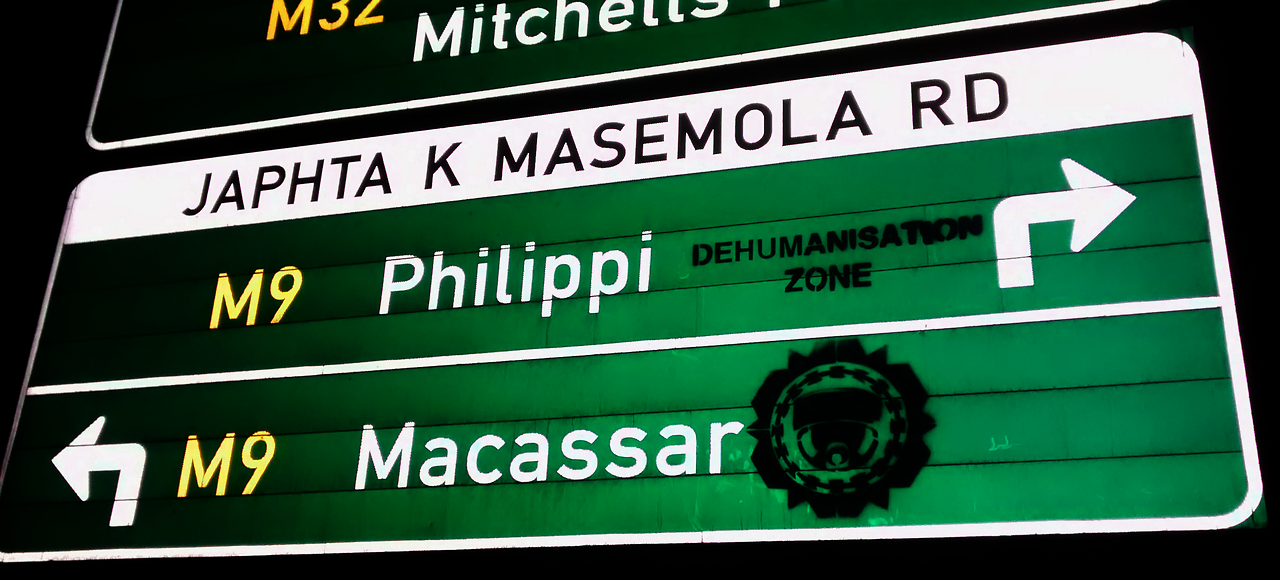
A traffic sign showing how to get to Khayelitsha, a ‘dehumanisation zone’. Image source: http://tokolosstencils.tumblr.com/. Used with permission from The Tokolos Stencil Collective.
A South African anonymous radical art collective, Tokolos-Stencil, is using stencil art to keep the memory of the 2012 Marikana mine massacre alive, disrupt colonial and apartheid statues, “terrorise the powers that be” and remind South Africans that if they want freedom and justice, they must be willing to fight for them.
Tokolos is a slang for Tokoloshe, a mischievous, dwarf-like spirit in Zulu mythology that becomes invisible by drinking water.
Writing about its work on the Africa is Not a Country blog, the collective says:
The Tokoloshe emerges from its secret lair. Like a thief in the night, it creates a mirror image of ourselves in some of the most contrary of places and then instantly vanishes.
These living pictures take us deep into the contradictions of our society. They take us back to our bloody, violent and racist history; they lay bare the smokescreens of popular culture showing us the oppressive reality of this purported democracy; and they create echoes of indignation at injustice while also reflecting on our own role in maintaining such cruelty.
Tokolos-Stencil has been putting up its “disruptive” artwork in many parts of South Africa, particularly Cape Town. Their work has appeared in government buildings, offices of political parties, highways, on bridges and public statues and even on private property such as American fast food chain McDonald's and a Ferrari dealership.
The collective encourages South Africans to download and spray paint their artwork in public places. Protesters used their artwork in support of a platinum mineworkers’ strike in May 2014 outside parliament.
“Remember Marikana” is the collective's main campaign, which is meant to remind South Africans and the authorities not to forget 16 August, 2012, when members of the South African Police Service killed 34 Lonmin mine workers and wounded at least 78 people. The incident is the deadliest use of force against civilians by the police force in post-apartheid South Africa.
One if its artworks about Marikana features Nelson Mandela, who is quoted in a fictitious African proverb:
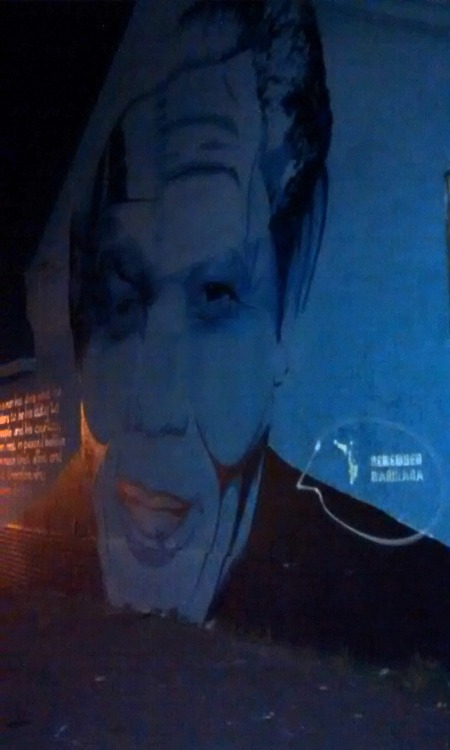
Image source:http://tokolosstencils.tumblr.com/. Used with permission from The Tokolos Stencil Collective.
Nelson Mandela says “Remember Marikana”
“If Madiba says it, it must be true.” – African Proverb
The “man in the green blanket” trademark for “Remember Marikana” (see the image below) is the iconic image of Marikana workers’ leader Mgcineni Noki, who was killed by police in August 2012:

Image source: http://tokolosstencils.tumblr.com/. Used with permission.
The [African National Congress] ANC must remember what they did to the people of Marikana. [South Africa's Deputy President] Ramaphose, [South Africa's President] Zuma, [South Africa's Police Commissioner] Phiyega and [South Africa's Minister of Police] Mthethwa are complicit in mass murder.
This stencil was done outside the ANC offices in Mowbray, Cape Town.
When the collective was invited by Brundyn+ Gallery to exhibit at the “bourgeois” art gallery's #FirstThursdays initiative, they decided to disrupt the gallery's “space of exclusion”:
We feel that the entire #FirstThursdays initiative is an exclusionary space meant to help the middle class pretend that their culture is significant and relevant. Instead, First Thursdays merely serves to exclude the poor black underclass. Many of the art installations talk about the poor but rarely if ever do they actually build space of inclusion.
In order to disrupt this space of exclusion, Tokolos deposited an unsanctioned installation of its own: a pota-pota toilet from a Khayelitsha shack settlement. These disgusting plastic laptop toilets are completely unsanitary and yet thousands of people live with them every day. By placing the toilet in the middle of Hipster Heaven, we hope we disrupted the space and made visible, even if for only a few minutes, those who are generally unseen.
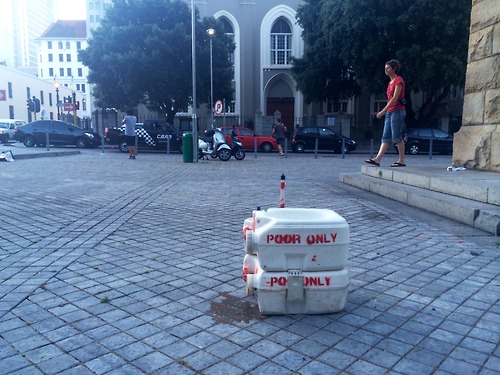
A portable toilet known to Cape Town's poor residents as a “porta-porta” or a “laptop”. The toilet was used as a disruptive installation Brundyn+ Gallery and Open City (Church Square) in Cape Town. Image source: http://tokolosstencils.tumblr.com/. Used with permission.
The collective also uses its artwork to identify South Africa's “dehumanisation zones“:
Khayelitsha, a human dumping ground of about 1 million people was built by the apartheid government and continues to be maintained by the current neoliberal ‘democratic’ regime.
The townships are hell on earth. They are a space that dehumanises all those who live in it.
Stencil signs proclaim Langa township to be a dehumanisation zone:

Image source: http://tokolosstencils.tumblr.com/. Used with permission.
Langa is the oldest township in Cape Town. It was built to control and contain migrant Xhosa speaking blacks from outside Cape Town who came in search of work. Langa still serves this purpose which is why it only has two entrances – easy for the army to block off and control. The Langa Temporary Relocation Area is a dumping place for blacks who have been evicted from other land. Even though it is associated with the N2 Gateway Housing Project, few of the people dumped there with the promise of housing in the project ever receive houses.
Joe Slovo's dehumanisation zone in Cape Town:
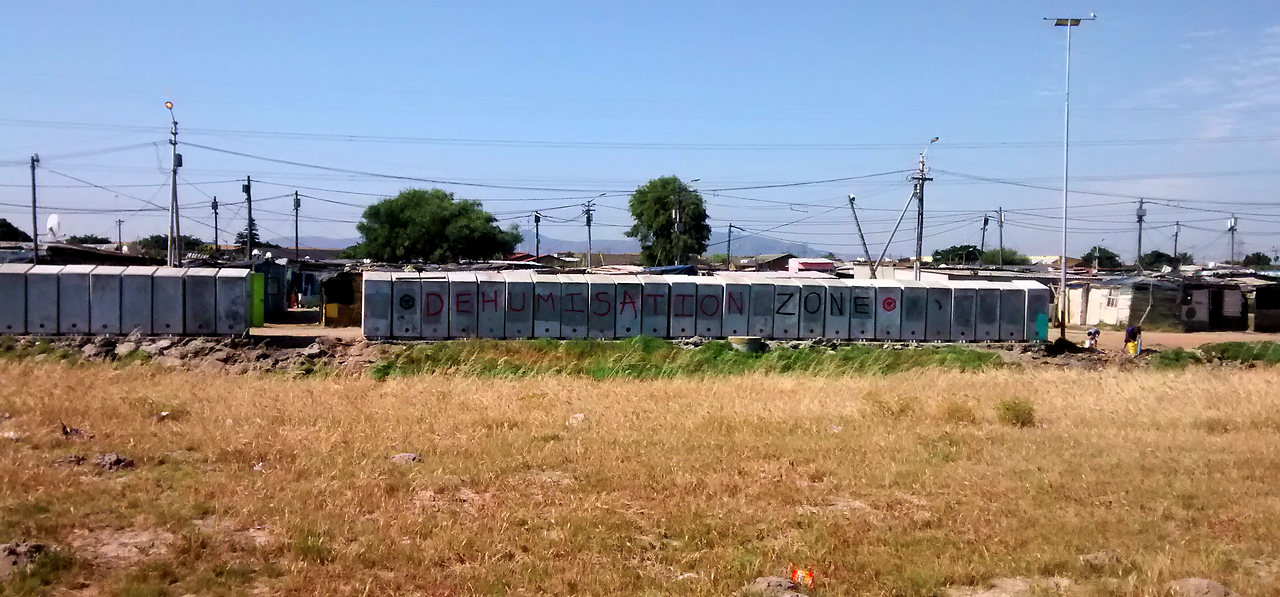
Joe Slovo shack settlement. Image source: http://tokolosstencils.tumblr.com/. Used with permission.
This is Joe Slovo shack settlement as visible from the N2 Freeway in Cape Town. It is one of hundreds of shack settlements of different sizes throughout Cape Town.
It exists out of necessity – because our land and housing policy is one continued dispossession of poor blacks who, with nowhere else to go, are crammed into tiny pieces of land in hellish townships.
The collective has embraced the word “terrorism” and even claimed full “responsibility for the act of terrorism against the heritage of White Supremacy in South Africa on the night of 20 October 2014″:
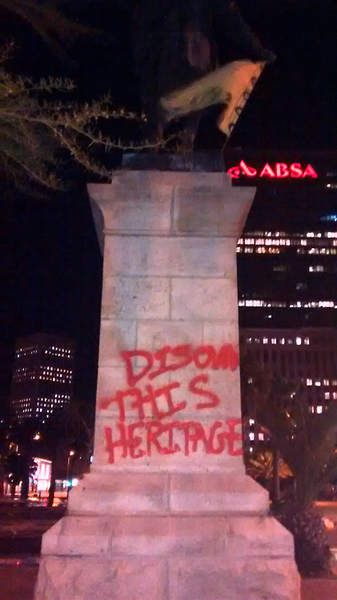
Disruption of colonial and apartheid legacy. Image source:http://tokolosstencils.tumblr.com/. Used with permission.
The collective used a Coca-Cola warehouse in Cape Town to paint a message of support to Palestinians saying “Coke Is Blood From Gaza“:
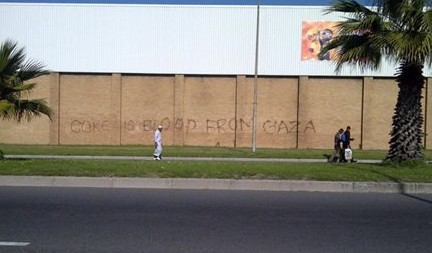
Image source: http://tokolosstencils.tumblr.com/. Used with permission.
On voting, the collective asked South Africans to vote in order to get “free lack of education”:
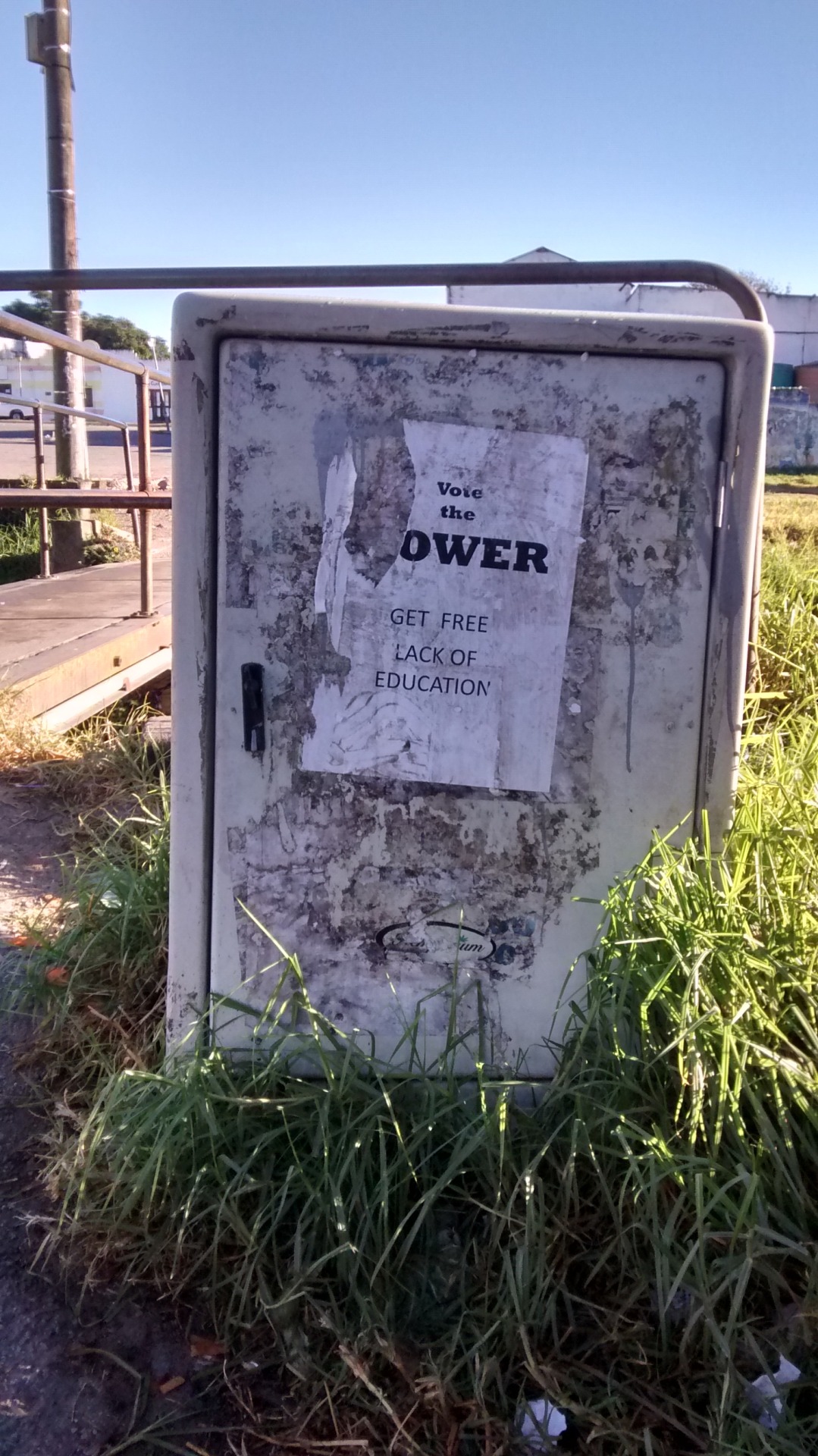
Image source: http://tokolosstencils.tumblr.com/. Used with permission.
On private schools:
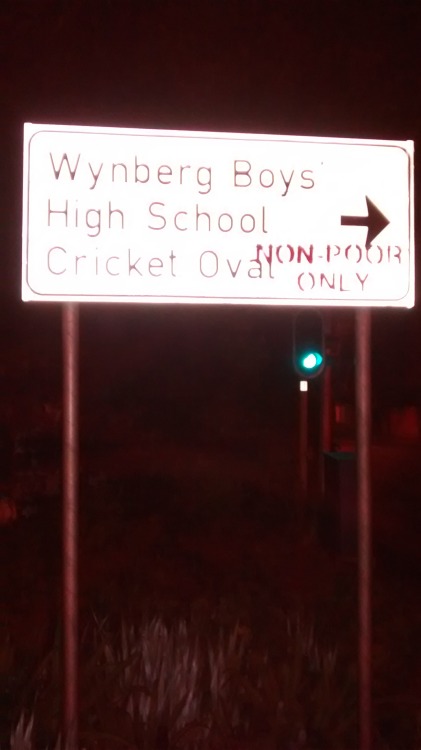
Image source: http://tokolosstencils.tumblr.com/. Used with permission.
Wynberg Boys’ High School. Like all private schools is NON-POOR ONLY.
#rememberyourpriviledge [sic]
On Cape Town Mayor Patricia de Lille's new drug awareness campaign:
“My name is Patricia de Lille and I have an elitism problem. I don’t use drugs but my anti-poor policies create hundreds of new addicts every day.”
If the City of Cape Town really wanted to address the the drug problem, they would realise that the city that works for a few is the problem [Cape Town's slogan is “The City That Works For You”].

Tokolos-Stencil's redesign of “The City That Works For You” slogan into “The City That Works For A Few.” Image source: http://tokolosstencils.tumblr.com/. Used with permission.
Tokolos disrupts the statue of Cecil John Rhodes at the University of Cape Town to remind South Africans that colonialism and the Marikana massacre are a part of a history of dispossession and murder of poor blacks:
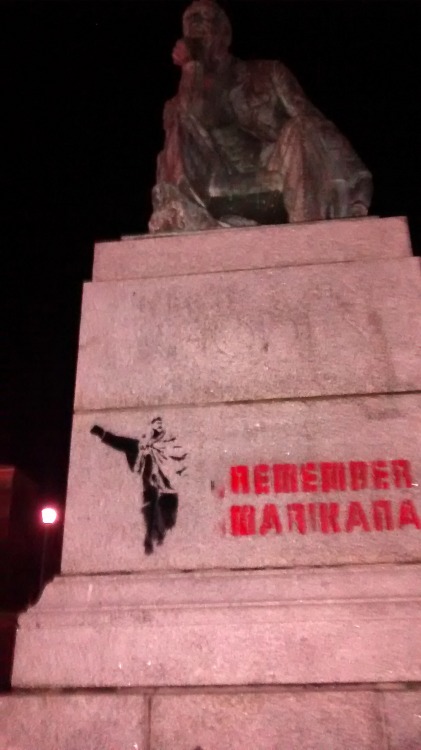
Image source: http://tokolosstencils.tumblr.com/. Used with permission.
“Cecil John Rhodes’ statue overlooking the Green Mile is a reminder of a man who held imperialist and racist views, but who also donated the [stolen] land on which UCT is built. Is it appropriate to give his memorial a place of honour on the UCT campus? Are we risking setting aside history? And should recognition of a gift extend into perpetuity?







1 comment